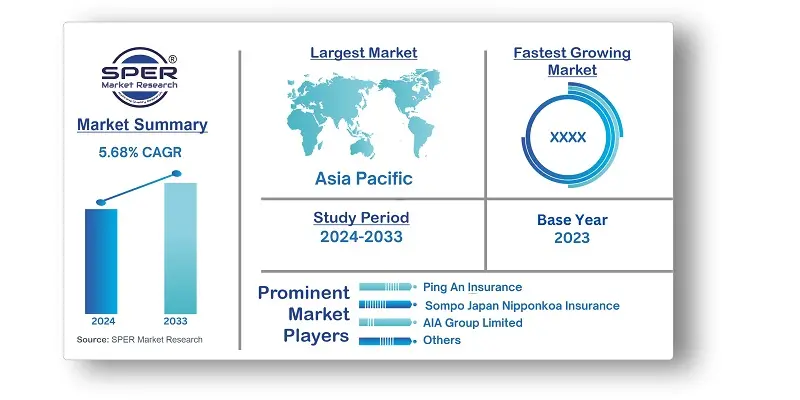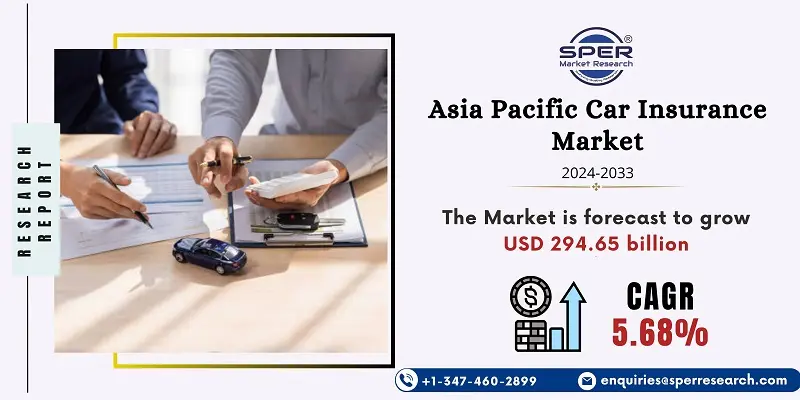
Asia Pacific Car Insurance Market Trends, Share, Size, Demand, Revenue and Future Outlook
Asia Pacific Car Insurance Market Growth, Size, Trends Analysis- By Coverage, By Application, By Distribution Channel- Regional Outlook, Competitive Strategies and Segment Forecast to 2033
| Published: Nov-2024 | Report ID: BFSI2431 | Pages: 1 - 156 | Formats*: |
| Category : BFSI | |||
- The "Switch" comprehensive motor insurance product was introduced by Edelweiss General Insurance in July 2022. It is a fully digital, mobile telematics-based policy that recognizes motion and initiates insurance immediately when the car is driven. This led to more growth in the direction of dynamically determined premium-based auto insurance services and real-time driving ratings.
- In July 2023, My Car Consultant Pte. Ltd., a Singapore-based provider of automotive solutions, partnered with Lexasure Financial Group, which operates in South and Southeast Asia in the areas of reinsurance, insurance, and insurtech solutions, to offer its data-driven, self-insured auto insurance in the region.


| Report Metric | Details |
| Market size available for years | 2020-2033 |
| Base year considered | 2023 |
| Forecast period | 2024-2033 |
| Segments covered | By Coverage, By Application, By Distribution Channel |
| Regions covered | Australia, China, India, Japan, South Korea, Rest of Asia-Pacific |
| Companies Covered | Ping An Insurance, PICC, Tokio Marine, MS&AD Insurance Group, Sompo Japan Nipponkoa Insurance, AIA Group Limited, IAG (Insurance Australia Group), Allianz Asia Pacific, Zurich Insurance Group, Bajaj Allianz General Insurance, HDFC ERGO General Insurance. |
- Individual Car Owners
- Commercial Fleet Operators
- Automobile Manufacturers and Dealerships
- Car Rental and Leasing Companies
- Insurance Companies and Providers
- Insurance Brokers and Agents
- Banks and Financial Institutions
- E-commerce Platforms Selling Insurance Policies
- Technology Providers (Telematics and InsurTech Solutions)
- Government and Regulatory Bodies
- Logistics and Delivery Companies
| By Coverage: | |
| By Application: | |
| By Distribution Channel: |
- Asia Pacific Car Insurance Market Size (FY’2024-FY’2033)
- Overview of Asia Pacific Car Insurance Market
- Segmentation of Asia Pacific Car Insurance Market By Coverage (Third-Party Liability Coverage, Collision/comprehensive, Optional Coverage)
- Segmentation of Asia Pacific Car Insurance Market By Application (Personal Vehicles, Commercial Vehicles)
- Segmentation of Asia Pacific Car Insurance Market By Distribution Channel (Direct Sales, Individual Agents, Brokers, Banks, Online, Other Distribution Channels)
- Statistical Snap of Asia Pacific Car Insurance Market
- Expansion Analysis of Asia Pacific Car Insurance Market
- Problems and Obstacles in Asia Pacific Car Insurance Market
- Competitive Landscape in the Asia Pacific Car Insurance Market
- Impact of COVID-19 and Demonetization on Asia Pacific Car Insurance Market
- Details on Current Investment in Asia Pacific Car Insurance Market
- Competitive Analysis of Asia Pacific Car Insurance Market
- Prominent Players in the Asia Pacific Car Insurance Market
- SWOT Analysis of Asia Pacific Car Insurance Market
- Asia Pacific Car Insurance Market Future Outlook and Projections (FY’2024-FY’2033)
- Recommendations from Analyst
1.1. Scope of the report1.2. Market segment analysis
2.1. Research data source2.1.1. Secondary Data2.1.2. Primary Data2.1.3. SPER’s internal database2.1.4. Premium insight from KOL’s2.2. Market size estimation2.2.1. Top-down and Bottom-up approach2.3. Data triangulation
4.1. Driver, Restraint, Opportunity and Challenges analysis4.1.1. Drivers4.1.2. Restraints4.1.3. Opportunities4.1.4. Challenges4.2. COVID-19 Impacts of the Asia Pacific Car Insurance Market.
5.1. SWOT Analysis5.1.1. Strengths5.1.2. Weaknesses5.1.3. Opportunities5.1.4. Threats5.2. PESTEL Analysis5.2.1. Political Landscape5.2.2. Economic Landscape5.2.3. Social Landscape5.2.4. Technological Landscape5.2.5. Environmental Landscape5.2.6. Legal Landscape5.3. PORTER’s Five Forces5.3.1. Bargaining power of suppliers5.3.2. Bargaining power of buyers5.3.3. Threat of Substitute5.3.4. Threat of new entrant5.3.5. Competitive rivalry5.4. Heat Map Analysis
6.1. Asia Pacific Car Insurance Market Manufacturing Base Distribution, Sales Area, Product Type6.2. Mergers & Acquisitions, Partnerships, Product Launch, and Collaboration in Asia Pacific Car Insurance Market
7.1. Asia Pacific Car Insurance Market Size, Share and Forecast, By Coverage, 2020-20267.2. Asia Pacific Car Insurance Market Size, Share and Forecast, By Coverage, 2027-20337.3. Third-Party Liability Coverage7.4. Collision/Comprehensive7.5. Optional Coverage
8.1. Asia Pacific Car Insurance Market Size, Share and Forecast, By Application, 2020-20268.2. Asia Pacific Car Insurance Market Size, Share and Forecast, By Application, 2027-20338.3. Personal Vehicles8.4. Commercial Vehicles
9.1. Asia Pacific Car Insurance Market Size, Share and Forecast, By Distribution Channel, 2020-20269.2. Asia Pacific Car Insurance Market Size, Share and Forecast, By Distribution Channel, 2027-20339.3. Direct Sales9.4. Individual Agents9.5. Brokers9.6. Banks9.7. Online9.8. Other Distribution Channels
10.1. Asia Pacific Car Insurance Market Size and Market Share
11.1. Asia Pacific Car Insurance Market Size and Market Share By Region (2020-2026)11.2. Asia Pacific Car Insurance Market Size and Market Share By Region (2027-2033)11.3. Australia11.4. China11.5. India11.6. Japan11.7. South Korea11.8. Rest of Asia-Pacific
12.1. Ping An Insurance12.1.1. Company details12.1.2. Financial outlook12.1.3. Product summary12.1.4. Recent developments12.2. PICC12.2.1. Company details12.2.2. Financial outlook12.2.3. Product summary12.2.4. Recent developments12.3. Tokio Marine12.3.1. Company details12.3.2. Financial outlook12.3.3. Product summary12.3.4. Recent developments12.4. MS&AD Insurance Group12.4.1. Company details12.4.2. Financial outlook12.4.3. Product summary12.4.4. Recent developments12.5. Sompo Japan Nipponkoa Insurance12.5.1. Company details12.5.2. Financial outlook12.5.3. Product summary12.5.4. Recent developments12.6. AIA Group Limited12.6.1. Company details12.6.2. Financial outlook12.6.3. Product summary12.6.4. Recent developments12.7. IAG (Insurance Australia Group)12.7.1. Company details12.7.2. Financial outlook12.7.3. Product summary12.7.4. Recent developments12.8. Allianz Asia Pacific12.8.1. Company details12.8.2. Financial outlook12.8.3. Product summary12.8.4. Recent developments12.9. Zurich Insurance Group12.9.1. Company details12.9.2. Financial outlook12.9.3. Product summary12.9.4. Recent developments
12.10. Bajaj Allianz General Insurance
12.10.1. Company details12.10.2. Financial outlook12.10.3. Product summary12.10.4. Recent developments12.11. HDFC ERGO General Insurance12.11.1. Company details12.11.2. Financial outlook12.11.3. Product summary12.11.4. Recent developments12.12. Others
SPER Market Research’s methodology uses great emphasis on primary research to ensure that the market intelligence insights are up to date, reliable and accurate. Primary interviews are done with players involved in each phase of a supply chain to analyze the market forecasting. The secondary research method is used to help you fully understand how the future markets and the spending patterns look likes.
The report is based on in-depth qualitative and quantitative analysis of the Product Market. The quantitative analysis involves the application of various projection and sampling techniques. The qualitative analysis involves primary interviews, surveys, and vendor briefings. The data gathered as a result of these processes are validated through experts opinion. Our research methodology entails an ideal mixture of primary and secondary initiatives.



Frequently Asked Questions About This Report
PLACE AN ORDER
Year End Discount
Sample Report
Pre-Purchase Inquiry
NEED CUSTOMIZATION?
Request CustomizationCALL OR EMAIL US
100% Secure Payment






Related Reports
Our Global Clients
Our data-driven insights have influenced the strategy of 200+ reputed companies across the globe.






















